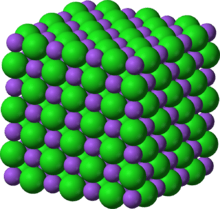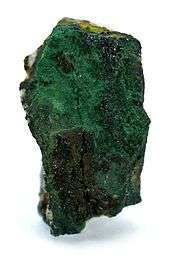Nickel(II) oxide
 | |
| | |
| Names | |
|---|---|
| IUPAC name
Nickel(II) oxide | |
| Other names
Nickel monoxide Oxonickel | |
| Identifiers | |
| 1313-99-1 | |
| ECHA InfoCard | 100.013.833 |
| PubChem | 14805 |
| RTECS number | QR8400000 |
| Properties | |
| NiO | |
| Molar mass | 74.6928 g/mol |
| Appearance | green crystalline solid |
| Density | 6.67 g/cm3 |
| Melting point | 1,955 °C (3,551 °F; 2,228 K) |
| negligible | |
| Solubility | soluble in KCN |
| Refractive index (nD) |
2.1818 |
| Thermochemistry | |
| Std enthalpy of formation (ΔfH |
-240.0 kJ/mol |
| Hazards | |
| Safety data sheet | JT Baker |
| EU classification (DSD) |
Carc. Cat. 1 Toxic (T) |
| NFPA 704 | |
| Flash point | Non-flammable |
| Lethal dose or concentration (LD, LC): | |
| LDLo (lowest published) |
5000 mg/kg (rat, oral)[1] |
| Related compounds | |
| Other anions |
Nickel(II) selenide Nickel(II) telluride |
| Other cations |
Palladium(II) oxide |
| Except where otherwise noted, data are given for materials in their standard state (at 25 °C [77 °F], 100 kPa). | |
| | |
| Infobox references | |

Nickel(II) oxide is the chemical compound with the formula NiO. It is notable as being the only well-characterized oxide of nickel (although nickel(III) oxide, Ni
2O
3 and NiO
2 have been claimed[2]). The mineralogical form of NiO, bunsenite, is very rare. It is classified as a basic metal oxide. Several million kilograms are produced in varying quality annually, mainly as an intermediate in the production of nickel alloys.[3]
Production
NiO can be prepared by multiple methods. Upon heating above 400 °C, nickel powder reacts with oxygen to give NiO. In some commercial processes, green nickel oxide is made by heating a mixture of nickel powder and water at 1000 °C, the rate for this reaction can be increased by the addition of NiO.[4] The simplest and most successful method of preparation is through pyrolysis of a nickel(II) compounds such as the hydroxide, nitrate, and carbonate, which yield a light green powder.[2] Synthesis from the elements by heating the metal in oxygen can yield grey to black powders which indicates nonstoichiometry.[2]
Structure
NiO adopts the NaCl structure, with octahedral Ni(II) and O2− sites. The conceptually simple structure is commonly known as the rock salt structure. Like many other binary metal oxides, NiO is often non-stoichiometric, meaning that the Ni:O ratio deviates from 1:1. In nickel oxide this non-stoichiometry is accompanied by a color change, with the stoichiometrically correct NiO being green and the non-stoichiometric NiO being black.
Applications and reactions
NiO has a variety of specialized applications and generally applications distinguish between "chemical", which is relatively pure material for specialty applications, and "metallurgical grade", which is mainly used for the production of alloys. It is used in the ceramic industry to make frits, ferrites, and porcelain glazes. The sintered oxide is used to produce nickel steel alloys. Charles Édouard Guillaume won the 1920 Nobel Prize in Physics for his work on nickel steel alloys which he called invar and elinvar.
NiO was also a component in the nickel-iron battery, also known as the Edison Battery, and is a component in fuel cells. It is the precursor to many nickel salts, for use as specialty chemicals and catalysts. More recently, NiO was used to make the NiCd rechargeable batteries found in many electronic devices until the development of the environmentally superior NiMH battery.[4] NiO an anodic electrochromic material, have been widely studied as counter electrodes with tungsten oxide, cathodic electrochromic material, in complementary electrochromic devices.
About 4000 tons of chemical grade NiO are produced annually.[3] Black NiO is the precursor to nickel salts, which arise by treatment with mineral acids. NiO is a versatile hydrogenation catalyst.
Heating nickel oxide with either hydrogen, carbon, or carbon monoxide reduces it to metallic nickel. It combines with the oxides of sodium and potassium at high temperatures (>700 °C) to form the corresponding nickelate.[4]
Nickel oxide reacts with chromium(III) oxide in a basic moist environment to form nickel chromate:
- 2 Cr
2O
3 + 4 NiO + 3 O
2 → 4 NiCrO
4
Health Risks
Long-term inhalation of NiO is damaging to the lungs, causing lesions and in some cases cancer.[5]
References
- ↑ "Nickel metal and other compounds (as Ni)". Immediately Dangerous to Life and Health. National Institute for Occupational Safety and Health (NIOSH).
- 1 2 3 Greenwood, Norman N.; Earnshaw, Alan (1984). Chemistry of the Elements. Oxford: Pergamon Press. pp. 1336–37. ISBN 0-08-022057-6.
- 1 2 K. Lascelles, L. G. Morgan, D. Nicholls, D. Beyersmann “Nickel Compounds” in Ullmann's Encyclopedia of Industrial Chemistry 2005 Wiley-VCH, Weinheim, 2005.
- 1 2 3 "Handbook of Inorganic Chemicals", Pradniak, Pradyot; McGraw-Hill Publications,2002
- ↑ "Toxicology and Carcinogenesis Studies of Nickel Oxide", U.S. Dept. of Health and Human Services, No. 451, 07/1996
External links
- Bunsenite at mindat.org
- Bunsenite mineral data
